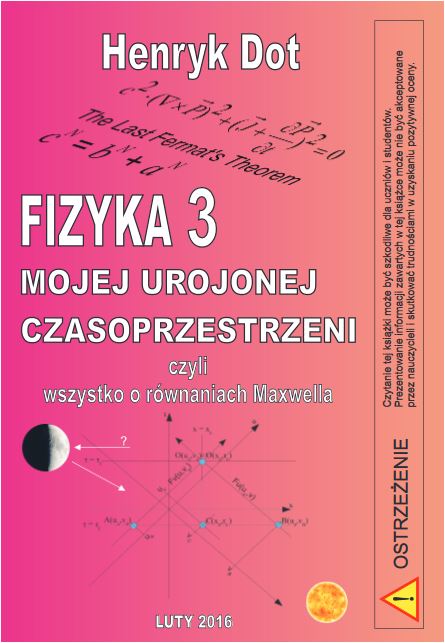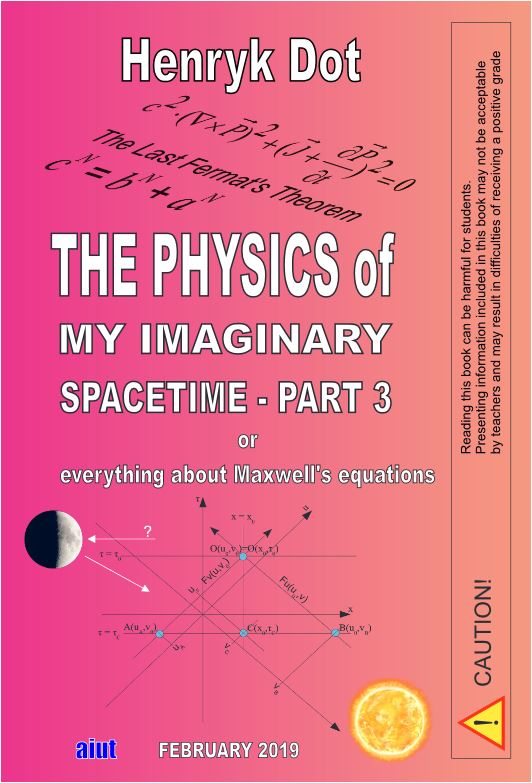★ HenrykDot.com
★
is the online companion to a series of books published by AIUT under the common main title
"Physics of My Imaginary Space-Time" by Henryk Dot.
is the online companion to a series of books published by AIUT under the common main title
"Physics of My Imaginary Space-Time" by Henryk Dot.
Physics 3 - Return
Return to Physics 3
Physics 4 -
Home
Introduction
Physics 4 - Chapter 1
Motion
Orbital motion
Return to Physics 3
Physics 4 -
Home
Introduction
Physics 4 - Chapter 1
Motion
Orbital motion
Contact
email: henryk.dot(at)aiut.com
"Subject" should begin with
a digit corresponding to the day
of the week., e.g. Sunday=7
"Subject" should begin with
a digit corresponding to the day
of the week., e.g. Sunday=7
Books published by AIUT
are found in libraries according to the list of compulsory copies.
Second Edition of "Fizyka 3"
ISBN 978-83-926856-1-6

can be bought in Warsaw
in the Academic Bookstore
PW Publishing House
Noakowskiego street 18/20
and in Katowice
in the bookstore "Liber"
Bankowa street 11.
(area of Silesian University)
English edition of "Physics"
ISBN 978-83-926856-2-3

is also in libraries
and the distribution method should be asked wydawca@aiut.com.
|
2. Orbital Motion
Considerations on orbital motion will be useful for further sections
of the book. | |
| (1.18) | |
| where: - position vector, - position vector length (modulus), - functional relation: acceleration dependence on distance. | |
| In our considerations, will take constant values,
as for example in the case of gravity
or for case of atom
where: - gravitational constant, - mass of the central object, - number of protons in a nucleus, - electron charge, - electron mass, - dielectric permittivity. | |
| Many consideration/conclusions are still
correct when
is not a constant but a function of i.e., . For the sake of clarity, we begin our considerations with an assumption that the central object is stationary and its interaction is immediate. This has no significant impact on the validity of the conclusions drawn at this stage. In some problems, a consideration of the motion of the central object and the delay of its interaction will be very important, but we will deal with these in another section. Orbital motion is conveniently analyzed in polar coordinates and such as: | |
| , | (1.19) |
| . | (1.20) |
| We obtain then the following relations | |
| (1.21) | |
| (1.22) | |
| , | (1.23) |
| . | (1.24) |
| Inserting (1.23) and (1.24) respectively into (1.18) we obtain: | |
| (1.25) | and |
| . | (1.26) |
|
Now, performing multiplications (1.25) and (1.26) by
and
respectively, then adding, and then subtracting both equations by sides and finally replacing the expression with new variable we obtain very clear and simple formulas (1.27) and (1.28). | |
| (1.27) | |
| (1.28) | |
|
The same result can be achieved by changing coordinates, but then to show how these coordinates transform, we would need to do identical calculations. We can also rewrite formula (1.27) by expressing by , where - circumferential velocity or in other words tangential velocity to a circle with radius | |
| . | (1.29) |
|
It should be noted that formula (1.28) does not use any variables
besides and
and which is very important for farther considerations it does not contain the value ! We just obtained a complete set of orbital formulas (1.27) and (1.28). Very often instead of these two, only one formula is presented applicable to circular orbit: | |
| . | (1.30) |
|
It represents the specific case of formula (1.29), when
. However, formula (1.30) still can be useful for us. When we rewrite it in the form as below, | |
| (1.31) | |
|
it can be noticed that (using interesting relation from formula (1.17))
an object in orbital motion on circular orbit contains kinetic energy
equal to a half of the energy required to leave a field.
The velocity momentum is constant not only for orbital motion. If an object moves in a straight line with a constant speed, the constant velocity momentum is conserved in respect to any point lying outside the straight line of motion. The principle of conservation of angular momentum is directly related to the principle of conservation of velocity momentum. Formula (1.28) can be written as: | |
| (1.32) | |
| which results in | |
| (1.33) | |
| and after substitution of by | |
| . | (1.34) |
| It is the same as | |
| (1.35) | |
| thus | |
| (1.36) | |
| and this allows us to express our desired rule without using a mass . | |
| (1.37) | |
|
Obviously, since
thus
must be a constant value as well. Formula (1.37) is equivalent to its three-dimensional vector representation: | |
| (1.38) | |
|
Relation shown in (1.37) can be used as constant in the formula (1.29),
which then be expressed as: | |
| (1.39) | |
|
If and
are constant, the expression
is also constant and it determines certain radius, which we can denote as and then express formula (1.39) as: | |
| (1.40) | |
|
This formula is very interesting, and together with (1.37) encompasses a different approach in presenting the property known as the Laplace-Runge-Lenz(LRL) vector. | |
|
Let us try to find some interesting features of equation (1.40). Let be denoted as a radial component of the velocity | |
| (1.41) | |
| We can then use the following relation | |
| (1.42) | |
| and express equation (1.40) as: | |
| (1.43) | |
| In this equation, the variables are conveniently separated, so we can integrate on both sides of the equation, yielding: | |
| (1.44) | |
|
where is an integration constant. We can also eliminate the ½ coefficient on the left side of the equation: | |
| (1.45) | |
| To determine integration constant we will take advantage of the fact that at certain extreme points , radial speed equals zero. We can write the equation for these points: | |
| (1.46) | |
| which leads to a quadratic equation: | |
| . | (1.47) |
| The equation has two solutions: | |
| (1.48a) | |
| and | |
| (1.48b) | |
| Denoting: | |
| (1.49) | |
| formula(1.48) can be written as: | |
| (1.50) | |
|
and |
|
| We easily notice that | |
| (1.51) | |
| and | |
| . | (1.52) |
|
In addition (1.51) represents the sum of the distances from any point
on the perimeter to both foci of the ellipse which are used to plot the ellipse. Thus equation (1.45) can be expressed as: | |
| (1.53) | |
| and then including (1.51) and (1.52) | |
| (1.54) | |
| The same result can be yielded when using energy formulas. | |
| (1.55) | |
|
where: – total energy, – total speed. For orbital motion, the total energy of such system is negative. Calculations will be easier to conduct when we relate the energy to a unit of mass and, we denote it with the index i.e. | |
| (1.56) | |
| By substituting total speed by its components, we obtain: | |
| (1.57) | |
| which is equivalent to formula (1.45) best visible after equation expressions are rearranged | |
| (1.58) | |
|
and it is the same equation since:
and . This prompted a suggestion to associate radius with energy and assign the index to it. When deriving the formula for relation (1.55) was not used to avoid the use of the terms work and energy, which we had not defined before. They are referenced only to demonstrate full compatibility of mathematical derivations. The new values introduced as radii and seem to better reflect the parameters of the ellipse than the popularly used term– eccentricity. | |
| Then the equation of an ellipse using and values: | |
| (1.59) | |
| and in parametric form, which is easy to plot: | |
| (1.60a) | |
| (1.60b) | |
| It is useful to remember the characteristic values: | |
| longer semi-axis of an ellipse , | (1.61) |
| shorter semi-axis , | (1.61a) |
| amplitude of a radius changes . | (1.61b) |
|
Amplitude of a radius changes corresponds to the distance of the foci of
the ellipse from the center of the ellipse and is directly related to
commonly used concept - eccentricity.
The characteristic quantities can be supplemented with the time of the ellipse circulation, which in our case represents the period of radius change i.e. the transition time from the maximum radius to the minimum radius and back to the maximum radius. To obtain this value, it is sufficient to calculate half of this period that is, the transition time from the minimum to the maximum radius. We will use the definition of radial velocity | |
| (1.62) | |
| Thus, | |
| and | (1.63) |
| Substituting with formula (1.54) we obtain (1.54) | |
| (1.64) | |
|
then, after solving the integral and results with the answer | |
| . | (1.65) |
| From formula (1.65) we derive Kepler’s Third Law | |
| . | (1.66) |
|
The description of orbital motion proposed here using two parameters, and characterizes the properties of orbital motion very well. Keeping either parameter or constant, we obtain two families of orbits shown in the figures below, one with constant energy and the other with constant velocity momentum (Fig. 2). The radius corresponds to the energy and also determines the radius against which the value varies with amplitude . The radius determines the radius with respect to which the direction of the force changes along the radius. For here is an attraction, and for a repulsion. For an ellipse family of constant energy, i.e., constant , two extreme cases are interesting. First when and the orbit is circular and the second when approaches zero and the orbit approaches a straight-line segment (shown as green line in the picture). The latter case is practically impossible, but still interesting. To illustrate the effect of fixed and in both figures, the origin of the coordinate system is placed at the first focus. | |
|
Fig. 1 shows a family of orbits with equal energy – fixed
. and varies from zero to in intervals . | |
|
| |
| Fig.1. | |
|
Fig. 2 shows a family of orbits with constant velocity momentum -fixed . varies from to in intervals . | |
|
| |
| Fig.2. | |
|
| |
© 2020 Henryk Dot -
